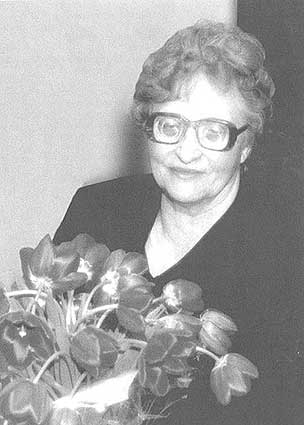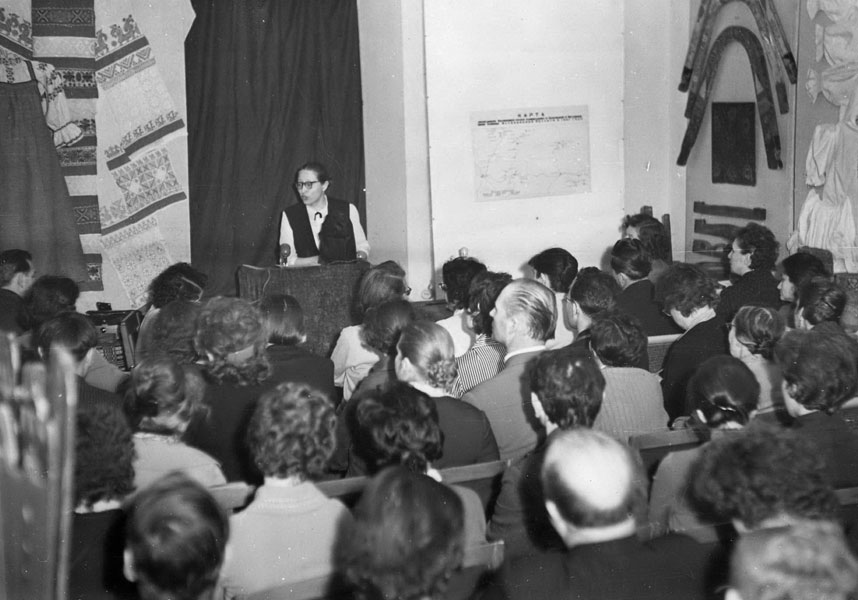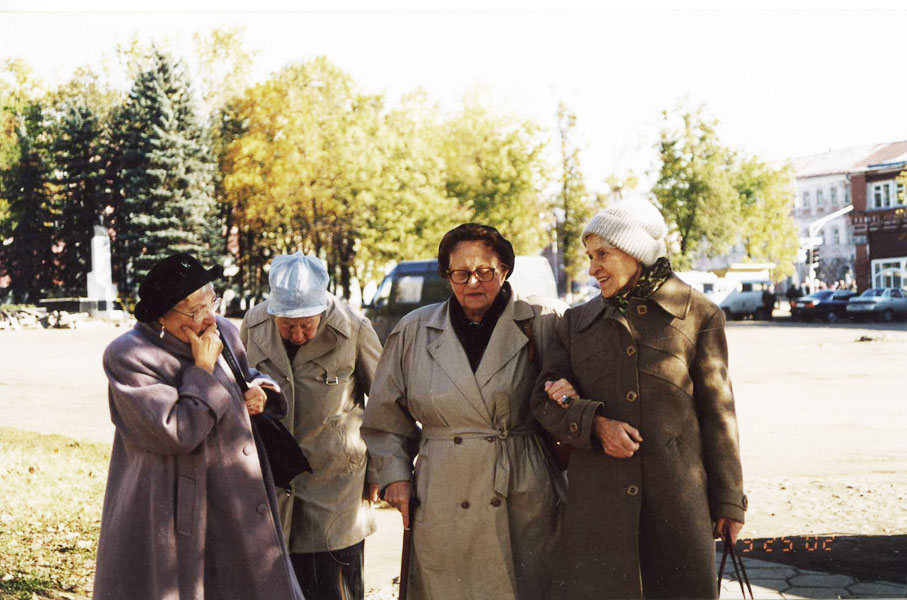Memoirs of Natalya Andreyevna Mayasova
 I worked in the Zagorsk History and Art Museum over seventeen years between 1945 and 1962 and I want to share my memoirs with you.
I worked in the Zagorsk History and Art Museum over seventeen years between 1945 and 1962 and I want to share my memoirs with you.
I came to the Museum in March 1945. The Great Patriotic war was not over, but the Museum treasures, saved in Solikamsk, had returned from the evacuation. The permission to be present at their receiving was a great joy for me. My destiny was determined at once. I realized that my place was not at school where I worked through the whole war, but here, with these greatest works of Russian art. The time was hard – there was lack of both finances and people.
Since 1929 the Museum had had a local history and anti-religion status. Among its constantly changing directors a part of historians there sometimes were drivers or loaders. At the beginning of 1945 the Museum was luckily managed by an architect V.K. Ryakhovsky, deputy director was an art historian with an experience of the Leningrad museums Yu. A. Lebedeva (who subsequently maintained a thesis on Andrei Rublev’s art. Chief curator was an old and devoted Museum specialist (working since 1969), historian A.M. Popova-Kurbatova. The Museum had a restoration section, supervised by I.V. Trofimov since 1938. The authoritative Scientific Council included competent art historians, historians, archeologists, architects and engineers. All those circumstances provided an opportunity to restore History and Art Museum Status.
One of the first steps in that direction was the Exhibition of Old Russian Art in the Monastery Sacristy created under direction of Yu. A. Lebedeva. I also took part in its organization. Installing was carried out by an experienced engineer N.N. Saveliev. He also assembled the iconostasis of the Trinity Cathedral restored by a famous specialist N.A. Baranov. The Exhibition of Old Russian Art, its decoration and exhibition complexes changed several times, but its content was preserved as determined in 1946. For the 800th anniversary of Moscow, celebrated in 1947, A. M. Kurbatova and I organized the exhibition “The Defense of the Fortress of the Trinity-St. Sergius Monastery against the Polish-Lithuanian Invaders at the Early 17th Century”. The exhibition was housed in the Water Tower. The interior of the Metropolitan Chambers was reconstructed for demonstration. When the Chambers and other Lavra buildings passed to the Moscow Patriarchy, the exhibition “Russian Art of the 18th Century” was opened in the former Vicegerent Residence. It was designed by an art historian O.E. Esipova (Scientific Secretary between 1945 and 1951). She was inexhaustibly energetic despite her serious disease. Her wonderful kindness united the staff for many years. Her exhibition was greatly changed, but preserved. Leaving the Museum, she was in charge of the Art Works Archive till her death in 1972. The Archive belonged to the USSR Ministry of Culture and occupied two Lavra towers.
After the war A.M. Kurbatova prepared a group of the Museum curators with secondary school education, but extraordinarily scrupulous and devoted to their work. The group included I.F. Kazakov, E.K. Rabinovich-Solntseva, N.N. Prasolova who came before the war. Some pre-war guides - S.S. Ragulina, T.A. Kruchkova - were still working. After the war an artist V.E. Karavai came to work as a guide. My task was to write methodical instructions for the tour of the architectural ensemble and all expositions. Those instructions were used for many years. In addition to the departments based on the Lavra collection, they began to form the department of Russian Folk Art before the war. Between 1940 and 1960 there worked an elder citizen of Zagorsk, an artist and enthusiast of Bogorodskoye carved toys T.K. Grushevskaya, L.N. Baikova, an art historian Z.S. Supishchikova. V. N. Dokuchayeva (an art historian) worked for about two years. They organized the first big exhibition of folk art.
In 1948 – 1949, the Commission of the USSR Ministry for Finances worked in the Museum. Its mission was to check the works of precious metals and stones. Being a post-graduate student, I worked for three days as a Museum representative in the Commission. So, I remember that hard time very well. The Museum and its Chief Curator, in particular, honorably passed the test, receiving no serious criticism from the Commission. At the same time an architect I.V. Trofimov helped to organize the first exhibition dedicated to history and restoration of the architectural ensemble. It was widely recognized, and its thematic and exhibition plan was admitted as my post-graduate theme. Later the exhibition was expanded and renovated by other specialists. A discouraging obstacle was frequent change of the Museum directors. V.K. Ryakhovsky was replaced by I.I. Belkin and I.I. Belkin was temporarily replaced by B.S. Shchipanov and then by Chigir. Deputy director Yu.A. Lebedeva, who started the Museum reconstruction, could not achieve understanding with I.I. Belkin, left for the Russian Museum in Leningrad in 1951. She was replaced by V.T. Kotov from the Palekh Museum. Between 1952 and 1962 I was to direct the scientific research. Those were the most memorable years of my life for we were young and full of energy, we loved the Museum and we were interested in our work. And, what was most important, we formed a strong, enthusiastic group, devoted to the Museum.
The group’s kernel included Chief Curator O.A. Belobrova ( worked between 1954 – 1964), a graduate of the Art History Department of the Leningrad University (now Candidate of Philology in Pushkin House); Head of History and Art Department since 1948 T.V. Nikolayeva (subsequently a famous scholar, Professor of History in the Institute of Archeology of the USSR Academy of Science); senior research worker T.N. Kedrova; Head of Folk Art Department, O.V. Kruglova (art historian) and her colleague, art historian L.E. Kalmykova. When A.M. Kedrova retired in 1958, E.N. Klitina was appointed in charge of the Museum depositories.
The well coordinated staff managed to overcome one of the most dramatic episodes of the Museum history, when in summer, 1954, General Secretary G.M. Malenkov, himself, signed the direction on passing the whole collection of the Museum treasures to the Armory Chamber of the Moscow Kremlin. Actually, it was the end of the Museum. We decided to struggle. Taking advantage of the lame preliminary arrival of the commission on our day off, we considered the circumstances and got ready. I was in the most difficult situation. I acted for the Director (Oksky was undergoing a course of medical treatment in sanatorium) and had to take the responsibility upon myself. But I had the secure rear. We agreed that those who would be present at the meeting would be reserved. I remember the short phrases I exchanged with the visitors (N.Ya. Nersesov from the Ministry of Culture, General A.Ya. Vedenin – Commandant of the Kremlin, Director of the Armory Chamber N.N. Zakharov and somebody else):
- Do you know why we have come? How shall we work?
— I’m sorry, but we won’t let the Sacristy go!
— Do you know that this is the Government resolution?
— Yes, but the Government is misled! We’ll explain. The Museum was founded by the Decree signed by V.I. Lenin himself.
— Is it your last word?
— Yes! — Can we see the Sacristy?
— You are welcome, it is open for all people!
The official men said no more about their mission, neither did we.
We were most of all afraid of G.A. Oksky arrival. Director could sign the document and it would be finished. But listening to our story, Oksky jumped up and said: “You are my dear Amazons! Go on like that!” Where did we not go or write. At last we composed a big letter which was signed by the leading scientists headed by Secretary of the Scientific and Methodical Council S.P. Grigorov (Chairman I.E. Grabar refused). We wrote letters for two years. Nobody wanted to transgress V.I. Lenin’s Decree! Then the power passed to N.S. Khrushchev and everything fell into oblivion. There was an attempt to separate the Department of Folk Art from the Zagorsk Museum. We wrote numerous letters and visited officials again. Our deputy, famous writer L.M. Leonov helped us..
At that time T.V. Nikolayeva carried out an interesting work. An experienced archeologist she observed all earth works on the Lavra territory, studied and published a number of articles on the tomb stones found in the course of those works. She also organized first expeditions to discover icons in closed churches. New research workers G.I. Vzdornov and L.M. Spirina joined her. All finds were reported at the conferences. At those years the Museum workers already had enough knowledge and experience. The Museum was paid respect to by the famous scientists participating in the conferences and scientific meetings with their reports. The collected material was published in the fundamental works. After the small informative book “Kratkiye soobshcheniya” (Brief Reports), in 1958 and in 1961 the Museum published in the Zagorsk Printing-House the second and third edition of “Soobshcheniya” containing the results of research highly estimated by the specialists. In 1960, the local printing-house managed to publish the comprehensive scientific catalogue of T.V. Nikolayeva “Proizvedeniya melkoi plastiki 13 – 17 vv. v sovranii Zagorskogo muzeya” (Small-Size Sculptures of the 13th – 17th Century in the Collection of the Zagorsk Museum). Scientific Secretary G.I. Bureichenko had tried hard lo organize the publication. At that time the representatives of the administration tried to avoid responsibility, they were discouraged by the Bible and Gospel themes of Old Russian art.
By the early 1950s many buildings of the Museum-Reserve passed to the Patriarchy and, unfortunately, their restoration was subsequently carried out without participation of the Museum workers. But the valuable collections of icons, textiles, embroidery, silver were systematically cared after by the highly qualified specialists of the I. Grabar Central Restoration Workshops. Between 1962 and 1968, beside me, the leading specialists T.N. Kedrova, O.A. Belobrova and T.V. Nikolayeva left the Museum. G.I. Vzdornov and I.I. Bureichenko had left before. However, our generation determined the main directions of the Museum development and made it a major museum in our country famous all over the world. The young specialists, who began to work with us and who came after, also serve the great course of propaganda and preservation of cultural and spiritual heritage for the future generations
N.Mayasova











